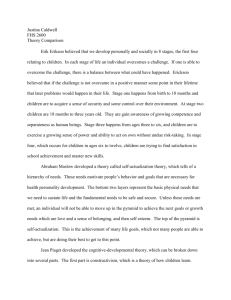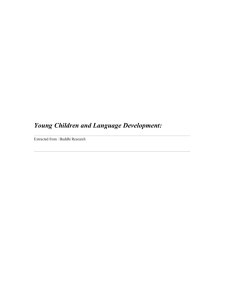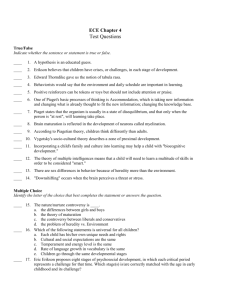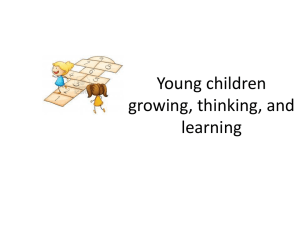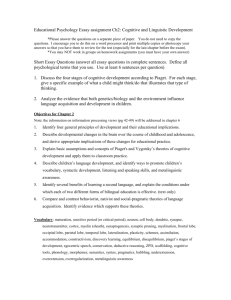Theories of Psychosocial and Cognitive Paper
advertisement
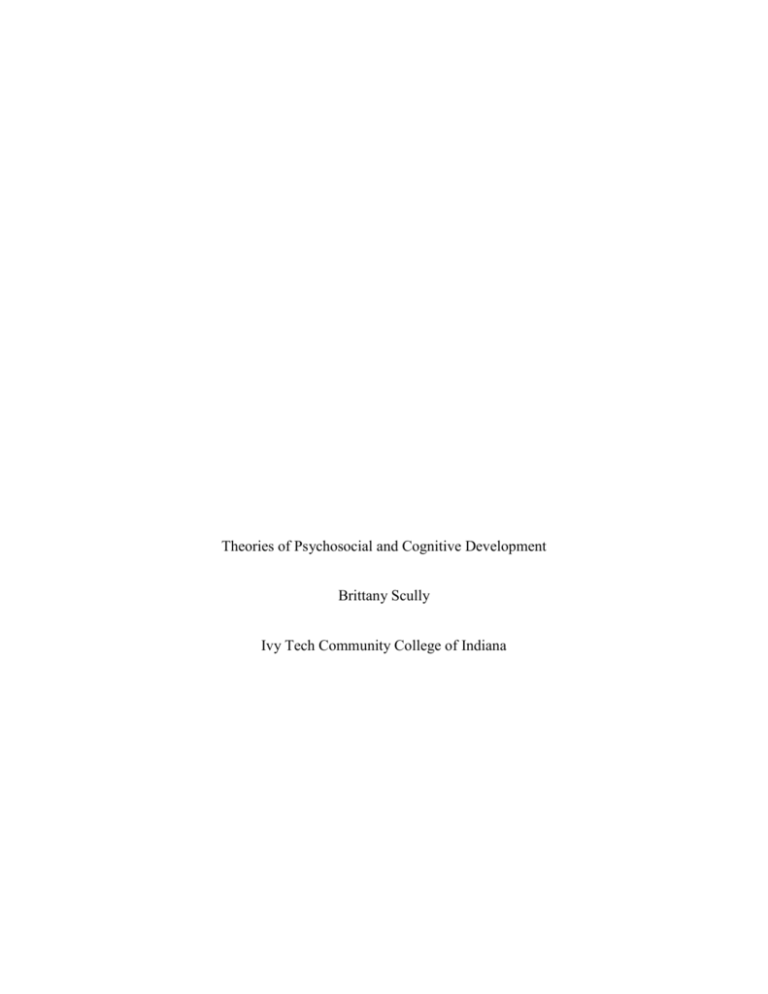
Theories of Psychosocial and Cognitive Development Brittany Scully Ivy Tech Community College of Indiana THEORIES OF DEVELOPMENT 2 Abstract Three leading theories of psychology are explained, applied, and evaluated in this paper. Erikson’s Theory of Psychosoical Development, Piaget’s stages of cognitive development, and Vygotsky’s theory of cognitive development are all thoroughly explained in this paper. Along with detailed descriptions of these three theories, examples of how each theory’s usefulness can be applied in the classroom are also included. To better evaluate each theory, this paper explores the strengths and weaknesses of the three theories. As a result, future educators are familiar with students’ developmental stages and are able to apply these theories, which provide the best learning experiences possible. THEORIES OF DEVELOPMENT 3 There are three leading theories that have paved the way in determining how one develops and learns. These theories have allowed educators the opportunity to provide positive and constructive learning environments for students. These theories can be used as protocols to assist teachers in accommodating students’ various developmental and learning stages. From evaluating each theory’s strengths and weaknesses, one is able to decipher which theory is the most appropriate for their classrooms’ needs. Psychosocial development refers to the mental development of how people interact and adapt to their environment. How a person psychologically develops, in a social setting throughout their life, affects their identity. The process begins during infancy and lasts throughout maturity and old age. Erik Erikson believed children developed in a “predetermined order”. With that belief in mind, he developed the Theory of Psychosocial Development. His theory is based on two principles, the epigenetic principle and psychosocial crisis. The epigenetic principle was Erikson’s idea that environmental factors have an influence on the characteristics and genes one is born with. Psychosocial crisis refers to each stage Erikson developed. From progressing through each stage, Erikson’s theory states that positive, as well as negative qualities are obtained. People successfully adapt to their environment when they possess both a negative and positive quality. However, the positive qualities must outweigh the negative ones. If the negative qualities outweigh the positives qualities, it leads to failure of that stage and prevents progression to the next one. One can only continue to the next stage if the previous one is THEORIES OF DEVELOPMENT 4 successfully completed. Five to eighteen years old is a crucial time in adolescents’ social and emotional development. According to Erikson, five year olds’ main conflict is initiative versus guilt. If successful in this crisis, children feel secure with themselves and the decisions they make. If children are too controlled, they are left feeling guilty and will lack initiative. Six to eleven year olds deal with the conflict of industry versus inferiority. This is when children develop confidence and take pleasure in accomplishing goals. However if children are not praised for their accomplishments and effort, they instead develop inferiority. Twelve to eighteen year olds go through the development of identity versus role confusion. In this stage, adolescents learn to establish independence and explore various potential roles and capabilities as adults. If this stage is blocked or prevented from successful completion adolescents can become easily confused about who they are and what role they play in society (Snowman & McCown, 2012, p.29). This theory is very useful in the classroom, because it guides educators in how to promote and encourage a healthy and positive learning environment. Educators can do this through using significant types of instruction that are specific to each stage of development. To assist children in developing initiative, I would incorporate some sort of service learning project. My ideal activity would allow students to choose their own project. Students would be able to facilitate their own ideas and then perform them around the school. Once they have chosen an activity they would have to stick with it; it cannot be changed. I would allow time once a week for an entire semester for students to complete their service learning projects. Through their THEORIES OF DEVELOPMENT 5 planning, creativity, and making a difference around the school students establish initiative. To guide students in developing industry the goal is to incorporate an activity they will successfully accomplish and be competent in. In my classroom, the focus would be more on praise and encouragement, rather than the actual activity. To promote industry, it is critical for teachers to create an enjoyable atmosphere where students are encouraged to complete their tasks and praised for their effort in completing their tasks. Developing identity can be fostered through exploring various cultures. One activity I would assign to foster this would be a research presentation. Students would be assigned to pick a historical figure who shares a similar heritage or culture as them. They would write a paper about that person, how they compare to the students’ own culture or heritage, and present it in class. This allows students the opportunity to compare and contrast their lives to the ones they are listening to. It also give students the chance to learn about and explore their own culture and heritage. Unlike Erikson’s psychosocial development, Jean Piaget’s focus was more on cognitive development. Cognitive development refers to the alterations of cognitive procedures and capabilities; although Piaget refers to it as the way humans adapt to their environment. “Piaget was interested in how an organism adapts to its environment (Piaget described as intelligence.) Behavior (adaptation to the environment) is controlled through mental organizations called schemes that the individual uses to represent the world and designate action. This adaptation is driven by a biological drive to obtain balance between schemes and the environment (equilibration)” (Huitt & Hummel, 2003, p.3). THEORIES OF DEVELOPMENT 6 According to Piaget, two sub-processes are used throughout one’s life in effort to adapt, assimilation and accommodation. Assimilation describes the process of absorbing new information into an already established scheme. Accommodation involves changing one’s scheme to fit with the new information. It is important for children moving through the stages of Piaget’s Cognitive Development to maintain a balance between assimilation and accommodation. Piaget called this balance equilibration. He believed children were just as smart and capable as adults; they simply analyze and comprehend concepts differently. He produced stages to represent cognitive development. The first stage is called sensorimotor and involves those from birth to two years of age. In this stage, schemes are developed through sense and motor activities. Preoperational is the next stage. It involves children two to seven years old. During this stage, children learn to reason, develop imagination, and become able to represent objects with symbols. Seven to eleven year olds are classified in a stage known as concrete operational. Adolescents in this stage are capable of using logic and solving problems by generalizing from concrete experiences. The last stage is formal operational, which includes everyone eleven and older. Those in this stage gain the ability to think abstractly and hypothetical, as well as the ability to systematically solve problems (Snowman & McCown, 2012,p.39). Piaget’s theory is valuable and beneficial in classroom. In his theory, Piaget recommends teachers play an active role in mentoring and guiding students. To help students develop through the sensorimotor, bright colored objects and musical objects should be utilized to engage them in THEORIES OF DEVELOPMENT 7 an activity using their senses. For the preoperational stage, I would encourage the use of students’ imagination. Through dress-up, students would be able to put their imaginations to use. I would incorporate a dress-up activity with lessons students’ are currently learning. To assist in students developing in the concrete operational stage, I would fill up two glasses that are the exact same size with the same amount of water. Then I would pour the water into a glass that was the same size just a different shape. This would teach them conceptual principles. For the formal operational stage, my focus would be on encouraging logical reasoning skills. I would incorporate activities that would allow students to really brainstorm and deliberate their thoughts and views. Like Piaget, Lev Vygotsky also had a theory about cognitive development. However, Vygotsky had a different view on the major factors that play a role in forming cognitive development. Lev Vygotsky concluded that cognitive development comes from social interactions. He believed that these interactions later on suppress into cognitive processes. Vygotsky’s theory states that children learn through psychological tools. He describes these tools as “cognitive devices and procedures with which we communicate and explore the world around us” (Snowman & McCown, 2012, p.49). When these tools are passed down, children gain knowledge which in return advances their cognitive development. However Vygotsky clarifies, the only way for cognitive development to advance is if one includes mediation. Vygotsky defines the process of mediation as “when a more knowledgeable individual interprets a child’s behavior and helps transform it into an internal and symbolic representation that means the same THEORIES OF DEVELOPMENT 8 thing to the child as to others” (Snowman & McCown, 2012, p.50). Vygotsky also views the interaction with fellow peers as an adequate way to develop knowledge. The two main principles of Vygotsky’s theory are MKO and ZPD (McLeod, 2007). More knowledgeable others (MKOs) are those who have a better understanding and more experience than the learner (McLeod, 2007). ZPD is the zone of proximal development. ZPD refers to the difference between what a child can do on his/her own and what is done with help from a MKO (McLeod, 2007). Vygotsky declared that there is a difference in types of concepts learned in early childhood and concepts learned in actual school. Spontaneous learning takes place during early childhood. This is when children learn unsystematic concepts, how to talk, and how to classify objects (Snowman & McCown, 2007, p.50). Once children attend school they administer to scientific concepts. Vygotsky believed that these psychological tools can only be learned in an instructional classroom setting. These concepts allow students to systematically shape the environment around them (Snowman & McCown, 2007, p.51). Vygotsky’s theory is useful in the classroom due to his theory on learning from more knowledgeable and experienced others; this includes teachers and students alike. To promote Vygotsky’s theory in my classroom, I would use various collaboration activities. To incorporate the zone of proximal development, I would pair a student who has a wider zone with a student who has a narrower zone. This would allow students the opportunity to learn from one another. It also keeps the student, who has a wider zone interacting and occupied by helping the student with the narrower zone. In return, the student with the narrower zone will, hopefully, experience THEORIES OF DEVELOPMENT 9 a greater cognitive development. Each theory has strengths and weaknesses. For some, the strengths outweigh the weaknesses. One strength of Erikson’s theory is the fact it is broken down into eight concrete stages. Each stage is then explained in great detail and represents each stage of life. This sets his theory apart from the other two theories; which are briefer than and not as elaborate as Erikson’s theory. This strength, however, can also be considered a weakness. Some may view Erikson’s, as well as Piaget’s theory as too rigid, in the sense that not everyone develops at the same time or age. Neither theory leaves much room for development outside of the specified age range. A strength of Piaget’s theory includes the belief that children should learn at the level they are developmentally prepared for. Schools construct curriculum around children’s developmental stage and level; which leads to a weakness in Vygotsky’s theory. Vygotsky believed that curriculum should be aimed above students’ current capabilities. He thought this would act as a guide to pull them along in the direction of advancing cognitive development. If it actually works, then yes, it is great for a child. The problem occurs when it does not work; and it will not work for every child. Those it does not work for actually end up severely hurt, in more ways than one. Teaching what is just outside of students’ capacity can damage self-esteem, which leads to frustration and discouragement. The end result is a negative learning experience. In conclusion, all three theories have played a major role in determining how children develop and learn. In return, educators have been able to use these theories as guidelines to provide the most specific and significant curriculum and activities based on students’ THEORIES OF DEVELOPMENT 10 developmental stages. Although all three theories have strengths and weaknesses, they all aim at providing social and cognitive developmental stages to assist in the most positive learning experiences possible. THEORIES OF DEVELOPMENT 11 References Erikson’s Stages. (2011, Nov. 29). Retrieved from http://allpsych.com/psychology101/social_development.html Huitt, W., & Hummel, J. (2003). Piaget's theory of cognitive development. Educational psychology interactive, 3(2).Retrieved from https://studentlife.tamu.edu/sites/studentlife.tamu.edu/files/EDM%20Workbook.pdf THEORIES OF DEVELOPMENT 12 McLeod. (2007). Lev Vygotsky. Retrieved from http://www.simplypsychology.org/vygotsky.html#sthash.khoq50y3.dpbs Morgan. (2013). Classroom Activities Using Piaget’s Theory. Retrieved from http://www.ehow.com/info_8663307_classroom-activities-using-piagets-theory.html Nicolopoulou. (1993, Feb). Play, cognitive development, and the social world: Piaget, Vygotsky, and beyond. Human Development, Vol 36(1), 1-23. doi: 10.1159/000277285 Snowman,J., & McCown, R. (2012). Psychology Applied to Teaching. Belmont, CA: Wadsworth Cengage Learning. Vygotsky, L. S. (1978). Mind in society: The development of higher psychological processes. Cambridge, MA: Harvard University Press. Waterman. (1982, May). Identity development from adolescence to adulthood: An extension of THEORIES OF DEVELOPMENT theory and a review of research. Developmental Psychology, 18(3), 341-358. doi: 10.1037/0012-1649.18.3.341 13


